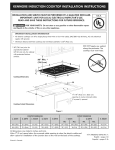Download Kenmore Elite 27'' Electric Combination Wall Oven Installation Guide
Transcript
iNSTALLATiON AND SERVICEMUST BEPERFORMED BYA QUALIFIED INSTALLER.
United States
qS!
IMPORTANT:
Canada
SAVE FOR LOCAL ELECTRICAL INSPECTOR'S USE.
READ AND SAVE THESE INSTRUCTIONS
FOR FUTURE REFERENCE.
FOR YOUR SAFETY: Do not store or use gasoilne or other
flammable vapors and liquids in the
vicinity
of
this or any other appliance.
Your new wall oven has been designed to fit a limited variety of cutout sizes to make the job of installing easier. The
first step of your installation should be to measure your current cutout dimensions and compare them to the cutout
dimensions chart below for your model. You may find little or no cabinet work being necessary.
Do not remove
spacers (if equipped)
side walls and/or
on the
1½" (3.8 crn)
Min.
an the back of
-
o1--
Electrical
Junction Box
Needed
(see note 4)
Figure 1
NOTES:
1. Base must be capable of supporting 350 pounds (159 kg).
2. Allow at least 21" (53.3 cm) clearance in front of oven for
door depth when it is open.
3. Dimension G (cutout depth) is critical to the proper
installation of the built-in oven. If the oven decorative
trim does not butt against the cabinet, or if noise is heard
on convection models, verify dimension G to assure it is
according to the required dimension.
PRO
MODEL
I
A
_'5. For a cutout height (H) between 451/8" (114.6 cm) and
467/8" (118.1cm) you can order a larger bottom trim
through your Service Center.
DUCT DIME NSION S
I
27" (68.6 cm) Walt Oven
27 (68.6)
30" (76.2 cm) Wall Oven
30 (76.2)
f
_4. For a cutout height (H) between 441/2" (113cm) and
451/8 '' (114.6cm) add a 2" (5 cm) ,,vide wood shim of
appropriate height to each side of the opening under the
appliance side rails. Lifting the unit wilt allow you to hide
the cutout openings showing above the unit. The bottom
trim of the unit wilt hide the shims at the bottom.
CUTOUT
I
C
45 9/T6(115.7)
45 9/_6(115.7)
DIMENSIONS
AND
CABINET
I
24 5/8 (62.5)
24_/2 (62.2)
28_/4 (71.8)
241/2 (62.2)
WIDTH
27" (68.6cm) Walt Oven
258/8 (65.1) 257/8 (65.7)
23_/2 (59.7)
44_/4 (112.4)
44_/2 (113)
27i/8 (68.9) Min
30" (76.2cm) Walt Oven
281/2(72.4)
23_/2 (59.7)
44_/4 (112.4)
44_/2 (113)
30i/8 (76.5) Min
All dimensionsare in inches (cm).
Printedin United States
29 (73.7)
P/N 318201546 (1011)Rev.A
English- pages 1-6
Espa_ol -paginas 7-12
ImportantNotesto
1.
2.
3.
4.
5.
6.
2. Electrical Requirements
the Installer
Read aii instructions contained in these installation
instructions before installing the combination oven.
Remove all packing material from the oven compartments
before connecting the electrical supply to the wail oven.
Observe all governing codes and ordinances.
Be sure to leave these instructions with the consumen
This appliance must be supplied with the proper voltage and
frequency, and connected to an individual, properly grounded
branch circuit, protected by a circuit breaker or fuse. To
know the circuit breaker or fuse required by your model, see
the serial plate to find the wattage consumption and refer to
table A to get the circuit breaker or fuse amperage.
Oven door may be removed to facilitate installation.
THIS COMBINATION
OVEN IS NOT APPROVED
FOR STACKABLE OR SIDE=BY=SIDE INSTALLATION.
Important
Note to the Consumer
Keep these instructions with your Owner's Guide for future
reference. Do not discard oven removal tools found in the
Appliance
Rating Watt s
24OV
Lessthan 4800W
!ance
Rating Watts
208V
I
Pr0tect_0n
Circuit
Recommended
20A
Lessthan 4100W
20A
- 7200W
30A
4100W - 6200W
30A
7200W
- 9600W
40A
6200W
- 8300W
40A
and +
50A
8300Wand+
50A
9600W
TabJe A
IMPORTANT SAFETY
INSTRUCTIONS
* Be sure your combination oven is installed and
grounded properly by a quallfied
installer or service
technician.
* This wall oven must be elecfrlcaily grounded in
accordance with local codes or, in their absence,
with the Natlonal Elecfrlcal Code ANSi/NFPA
No.70=
latest edition in United Sates, or wlth CSA Standard
C22.1, Canadian Electrlcal Code, Part 1, in Canada.
Stepping, leaning or sitting on the door
of thls wall oven can result in serious injuries and can
also cause damage to the wall oven.
* Never use your wall oven for warming or heating
the room. Prolonged use of the wail oven without
adequate ventilation can be dangerous.
The electrlcal
App
Circuit
Recommended
4800W
literature bag.
power to the oven must be
shut off while llne connections are being made.
to do so could result in serious injury or death.
I
Protection
Observe all governing
codes and local ordinances
I A 3wire or 4wire single phase 120/240 or 120/208 Volt,
60 Hz AC only electrical supply is required on a separate
circuit fused on both sides of the line (red and black wires).
A time-delay fuse or circuit breaker is recommended. DO
NOT fuse neutral (white wire).
NOTE: Wire sizes and connections
must conform with the
fuse size and rating of the appliance in accordance with the
American National Electrical Code ANSI/NFPA No. 70-{atest
edition, or with Canadian CSA Standard C22.1, Canadian
Electrical Code, Part 1, and local codes and ordinances.
An extension
cord should not be used
wlfh this appliance. Such use may result in a fire,
electrlcal shock, or other personal injury. If you need a
longer power cord you can purchase a 10' (3 m) power cord
kit by calling the Service Center.
.
Failure
These appliances should be connected to the fused
disconnect (or circuit breaker) box through flexible
armored or nonmetallic sheathed cable. The flexible
armored cable extending from the appliance should be
connected directly to the junction box. The junction box
should be located as shown in Figure 1 and with as much
slack as possible remaining in the cable between the box
and the appliance, so it can be moved if servicing is ever
necessary.
1. Carpentry
Refer to figure 1 for the dimensions applicable to your
appliance, and the space necessary to receive the
combination oven. The oven support surface may be solid
plywood or similar material, however the surface must be
leveled from side to side and from front to rear.
3.
A suitable strain relief must be provided to attach the
flexible armored cable to the junction box.
In cold weather shipping and storage
conditions, make sure that oven is in final location at least
three (3) hours before switching on power. Switching on
power while oven is still cold may damage the oven contro{s.
white
Electrical
Shock Hazard
* Electrical
ground is required on this appliance.
* Do not connect
to the electrical
supply
until
appliance
is permanently
grounded.
* Disconnect
power to the junction box before making
the electrical
connection.
* This appliance
must be connected
to a grounded,
metallic,
permanent
wiring system, or a grounding
connector
should be connected
to the grounding
terminal
or wire lead on the appliance.
* Do not use a gas supply
line for grounding
the
appliance.
Failure
to do any of the above
personal
could
injury or electrical
result in a fire,
shock.
3. Electrical connection
If is the responsibility and obligation of the consumer to
contact a qualified installer to assure that the electrical
installation is adequate and is in conformance with the
National Electrical Code ANSI/NFPA No. 70-latest edition,
or with CSA Standard C22.1, Canadian Electrical Code, Part 1,
and local codes and ordinances.
Risk of electrical shock (Failure to
heed this warning
may result in electrocution or
other serious injury.) This appliance
is equipped with
copper lead wire. If connection
is made to aluminum
house wiring, use only connectors that are approved
for joining copper and aluminum wire in accordance
with the National
Electrical Code and local code and
ordinances.
When instafflng connectors
having screws
which bear directly on the steel and/or aluminum
flexible conduit, do no tighten screws sufflclently to
damage the flexible
conduit. Do not over bend or
excessively
distort flexible
conduit to avoid separation
of convolutions
en exposure of internal wires.
DO NOT ground to a gas supply pipe. DO NOT connect
to electrical power supply until appliance is permanently
grounded. Connect the ground wire before turning on the
neutral
(if your appliance
conductor.)
is equipped
with
a
This appffance
is manufactured
with a white neutral
power supply and a frame connected
copper wire.
The frame is grounded
by connection
of grounding
lead to neutral lead at the termination
of the conduit,
if used in USA, in a new branch circuit installation
(1996 NEC), mobile home, recreational
vehicles, where
local code do not permit grounding
trough the neutral
(white) wire or in Canada, disconnect the white and
green lead from each other and use ground lead to
ground unit in accordance with local codes, connect
neutral lead to branch clrcult-neutral
conductor
in
usual manner see Figure 3. If your appliance
is to
be connected
to a 3 wire grounded
junction
box
(US only), where local code permit connecting
the
appllance-groundlng
conductor
to the neutral (white)
see Figure 2.
NOTE TO ELI:CTRICJAN:
The armored cable leads
supplied with the appliance are UL-recognized for connection
to larger gauge household wiring. The insulation of the leads
is rated at temperatures much higher than temperature
rating of household wiring. The current carrying capacity of
the conductor is governed by the temperature rating of the
insulation around the wire, rather than the wire gauge alone.
Where local codes permit connecting
the appffancegrounding
conductor to the neutral (whffe) wire (US
Only) (see figure 2):
1. Disconnect the power supply.
2. In the junction box:
Connect appliance and power supply cable wires as
shown in Figure 2.
Cable from Power Supply
White Wire
(Neutral)
Wires
_
:::::.;::___
IT
Y-J_/\'_
..:.- unction
power.
i "I,,. BoX
.....
i
Ground Wire _/
(Bare or Green Wire)
_-_{_
_- "
J
\White
(Neutral)
U.L-Listed Conduit
Connector
(or CSA listed)
Cable from appliance
3-WIRE
Wire
Figure 2
GROUNDED
JUNCTION
BOX
If oven
is used in a new branch circuit
4. Cabinet Installation
installation
(1996 NEC), mobile home, recreallonal
vehicle, or
where local codes DO NOT permit grounding through
the neutral (white) wire, the appliance
frame MUST
NOT be connected
to the neutral wire of the 4-wire
electrical system. (see figure 3):
1. Disconnect the power supply.
2. Separate the green (or bare copper)
cable wires.
3. In the junction box:
Connect appliance
shown in Figure 3.
Do not llft the oven by the door handle.
and white appliance
Heavy
* Failure to follow
and power supply cable ,,vires as
Wires--_'
,,'_
--'_-"---_ ,-White
Wire
Wire)
L_:_White
Wire
L] _
i _]_,' U"_.L.-Listed
Conduit
_r4_
and
Serial
Wire
Connector
Figure 3
GROUNDED
JUNCTION
Number
the
its handling and its installation.
1. Open oven door completely (horizontal with floor- See
Figure 4A).
2. Pull the door hinge locks on both left and right door hinges
down from the oven frame completely towards the oven
door (See Figure 4B). A tool such as a small fiat-blade
screwdriver may be required.
3. Firmly grasp both sides of oven door along the door sides
(Do not use the oven door handle- See Figure 4C).
4. Close the door to the broil stop position (the oven door ,,viii
stop into this position iust before fully closing).
5. With the oven door in the broil stop position, lift the oven
door hinge arms over the roller pins located on each side of
the oven frame (See Figure 4D).
6. Proceed in reverse to replace the oven door. Make sure the
hinge supports are fully engaged before unlocking the hinge
levers.
(or CSA listed)
Cable from appliance
Model
and to facilitate
of
To Remove Oven Door.
_/,
_ i_
4-WIRE
Remove the lower oven door to reduce the weight
appliance
_
Ground Wire
'
(Bare or Oreen---_
_ /
Junction Box
this instructlon can resuff in injury or
Unpack the wall oven. Remove the bottom trim and the
center trim taped on the oven side panel.
O
_-_
"X,[_.L_L>.I _
Hazard
damage to the unff.
Cable from Power Supply
Ground Wie--_
Weight
* Use 2 or more people to move and install wall oven.
BOX
Location
The serial plate is located along the interior side trim of the
oven and visible when the door is opened.
When ordering parts for or making inquires about your oven,
always be sure to include the model and serial numbers and a
lot number or letter from the serial plate on your oven.
NOTE: The oven door is very heavy. Be sure to have a firm grip
before lifting the oven door off the hinges. Use caution once
the door is removed. Do not lay door on its handle. This could
cause dents or scratches.
Door Hinge
locations
wffh oven
door fully
open
Figure 4B
4
J
Install now the bottom trim using the screws supplied with
the unit (Figure 6).
Roller
pin
Oven
door-
Remove atl packaging inside the ovens and remove the
lower oven racks and their supports (see owner's guide
for further instructions).
O
ind the 2 mounting screws included in the literature
package.
Screws
supplied
Insert the unit into the cabinet opening. Slide unit inward
leaving 11/t`` (3.8 cm) clearance
front of cabinet
between the unit and
(see Figure S).
Figure 6
Install now the center trim using the screws supplied with
the unit, on both sides (Figure 7).
I
0
Figure 5
O
Figure 7
Pull the armored cable through the hote for it in the
cabinet and toward the junction box while moving the
appliance
inward.
S
Install the Anti-tip Mounting
6. Checking Operation
Screws
The wall oven can tlp when the door is
open. The antl-tip
mounting screws supplied with the
wall oven must be installed to prevent tipping of the wall
oven and injury to persons.
A. The mounting holes in the side trims may be used as a
template to locate the appliance
mounting screw holes (see
figure 8).
B. Use the two screws supplied to fix the appliance
cabinet.
to the
Your model is equipped with an Electronic Oven Control
Each of the functions has been factory checked before
shipping. However, it is suggested that you verify the
operation of the electronic oven controls once more. Refer to
the Use and Care Guide for operation.
.
Remove all items from the inside of the oven.
2. Turn on the power to the oven (Refer to your Use & Care
Guide.)
3_
Verify the operation of the electronic oven controls:
Bake- Verify that this function makes the oven hot. 20
seconds after turning oven on, open the door and you
should feel heat coming from the oven.
Broil- When the oven is set to BROIL, the upper element in
the oven should become red.
Convection (some models)-When
the oven
a convection baking or roasting, both elements
and oF alternately and the convection fan will
convection fan wilt stop running when the oven
opened.
Before
is set for
cycle on
run. The
door is
You Call for Service
Read the "Before You Calt for Service Checklist" and the
"Operating
Instructions" in your Use and Care Guide.
It
may save you time and expense. The list includes common
occurrences
that are not the result of defective
workmanship
or materials in this appliance.
Refer to your Use and Care Guide for service phone
numbers.
Figure 8
5. Leveling the Wall Oven
1.
Install an oven rack in the
center of the lower oven
9.
(see Figure 9).
Place a level on the rack.
Take 2 readings with the
level placed diagonally
in one direction and
then the other. Use
wood shims under the
Figure 9
,,vail oven to level if
necessary.
iMPORTANT
NOTE
A coollng fan inside the upper rear part above
the oven (some models) provides cooling of the
oven electrical and eJectronlc components. If the
oven has been operating at high temperatures,
the fan will continue to run after the oven is
turned off.
LA INSTALACION Y EL SERVICIO DEBEN SER EFECTUADOS POR UN
Canada
INSTALADOR CAMFICADO. IMPORTANTE: GUARDE ESTAS INSTRUCCIONES
PARA USO DEL INSPECTOR LOCAL DE ELECTRICIDAD. LEA Y GUARDE ESTAS
iNSTRUCCIONES PARA REFERENCIA FUTURA.
I_
PARASU SEGURIDAD: No almacen_ nl utlJlcegasollna u otros
q
vapores ¥ liquldosinNamablesen Ja pro×imldad de este o de cualquler otto artefacto.
El primer paso para su instalaci6n debe de set el de medlr las dlmenslones de la apertura y compararlas con las
que se indlcan en el cuadro de dlmenslones del hueco de la figura 1. Poslblemente encontrar6
que algOn trabajo
de carplnteria set6 necesarlo.
I1_
No quite los separadores de los muros
laterales o/y de la parte posterior del homo empotrado.
Estos espaciadores
centran el homo en el espaclo provlsto.
EI homo debe estar cenfrado
-I
NOTAS:
necesario (vea nota 4)
1. La base debe poder sostener 300 libras (136kg).
2. Deje por Io menos 21" (53.3 cm) de espacio libre para la
(5 cm) de ancho con la attura adecuada
profundidad de la puerta cuando esta abierta.
3. La dimensi6n G (profundidad dei corte) est6 primordial
para instatar correctamente el horno de pared. Si
et adorno det armaz6n del horno no topa contra el
armario verifique si la dimensi6n G est6 en conformidad
con la dimensi6n requerida.
_4. Para una attura de cavidad (H) entre 441/2 '' (113cm)
y 451/8 '' (114.6cm), coloque cu_as de madera de 2"
I
A
i
27" (68.6 °m)
27 (68.6)
30" (76.2 cm)
30 (76.2)
cu_as de la parte inferior.
_5. Para una altura de cavidad (H) entre 451/8 '' (114.6 cm)
y 467/8 '' (119.1cm) puede soticitar una motdura inferior
m6s grande a trav&s de su Centro de Servicia
MODELO
-
DEL APARATO
B
=
C
45 V,_ (U5.7)
45
DIMENSIONES
Min.
9/16
en cada
lado de la abertura debajo de los rides laterales del
electrodom_stico. AI levantar Jaunidad podr6 ocultar las
aberturas de la cavidad visibtes en la parte superior de
la unidad. La motdura inferior de la unidad ocultar6 las
DIMENSIONES
MODELO
(izquierda)
Figura |
(]]5.7)
DEL HUECO f ANCHUFL_
I
I
D
24 s/_ (62.5)
24_/_ (62.2)
281/4 (71.8)
24V2 (62.2)
DEL ARMARIO
Min.
27" (68.6 cm)
25s/8 (65.1)
257/8 (65.7)
23V2 (59.7)
44V4 (112.4)
44_/t (113)
271/8 (68.9) Min
30" (76.2 cm)
28V2 (72.4)
29 (73.7)
23V2 (59.7)
441/4 (112.4)
44_/t (113)
301/8 (76.5) Min
Todas las dimensiones se dan en pulgadas
Impreso en los Estados Unidos
(cm).
P/N 318201546 (1011) Rev.A
English - pages 1-6
Espa_ol -paginas 7-12
Notas importantes
para el instalador
1. Lea todas ias instrucciones contenidas en este manual
2.
3.
4.
5.
6.
antes de instalar el combinaci6n microondas/horno
de
pared.
Saque todo el material usado en el embalaje del
compartimiento dei horno antes de conectar ei suministro
el&ctrico o de gas a la estufa.
Observe todos los c6digos y regiamentos pertinentes.
Deje estas instrucciones con el consumidor.
La puerta del horno se puede retirar para facititar la
instaiaci6n.
ESTE COMBINACION
MICROONDAS
/ HORNO
DE PARED NO ESTA APROBADO PARA LA
INSTALACI6N
APILABLE O DE LADO A LADO.
Nora importante
al consumldor
Conserve estas instrucciones
y ei manual del usuario para
referencia futura. No tirar los herrarnientas
para retirar el
horno incluidas en Ja bolsa de Ja Jiteratura.
* Aseg_rese de que su combinacJ6n rnicroondas /
homo de pared sea instalado y puesto a tlerra de
forrna apropiada pot un instalador calificado
o pot
un t_cnlco de servlclo.
" Este homo de pared debe set el_ctrlcarnente
puesto
a tierra de acuerdo con los c6digos locales o, en su
ausencla, con el C6dlgo El_ctrlco Naclonal ANSI/
NFPA No. 70-01tlrna edlci6n en los Estados Unldos, o
el C6dlgo El_ctrlco Canadlense CSA Standard C22.1,
Part 1, en Canad6.
PJsarr apoyarse, o sentarse sobre Ja
puerto de este homo de pared puede cousar serlas
leslones y dafios al homo de pared.
• Nunca
use su horno de pared para calentar
una
habitaci6n.
El uso prolongado de la estufa sin la ventitaciGn
adecuada puede ser peiigroso.
el_ctrlca
al homo
debe
Ei_ctricos
Se debe proveer el vottaje y la frecuencia
apropiados
a
este electrodom&stico,
y conectarse a un circuito individual
correctamente puesto a tierra, protegido por un interruptor o
un fusible. Para conocer ei interruptor o fusible que requiere su
modelo, vea la placa serial para encontrar la consumaci6n det
vatiaje y reflerase al flgura 2 para encontrar el amperaje del
interruptor o fusible.
arados
Vat0s
de
de
electroclom@stico
240V
Se recomienda
unaprotecc6n
al circuito
Grados de Vatios
J
J Se recomienda
de
, electrodom_stico
208V
unapratecc6n
al circuito
-
Menos de 4800W
20A
Menos de 4100W
20A
4800W - 7200W
30A
4100W - 6200W
30A
7200W - 9600W
40A
6200W - 8300W
40A
9600W and +
50A
8300W and +
50A
Table A
Observe
locales
INSTRUCCIONES
IMPORTANTES DE SEGURIDAD
La corrlente
2. Requerimientos
todos los c6dlgos
que goblernan
y ordenanzas
1. Un cable de 3 o 4 alambres monof6sico 120/240 o 120/208
vdtios, 60 hertzios es la Onica fuente et_ctrica que requiere
en un circuito separado en ambos lados de la linea (alambre
negro y alambre roio) (se recomienda un fusible o un
interruptor de retraso de tiempo). No funda a cable neutro
(alambre btanco). Se debe de tener precauci6n al combinar
un horno de pared y una cubierta, refl_rase a la placa de
seria de cada uno de los aparatos.
NOTA: Los tama_os y las conexiones del alambre deben
conformarse con et tama_o del fusible y el grado de la
aplicaci6n de acuerdo con el c6digo El_ctrico Nacional
Americano ANSI/NFPA No. 70- ultima edici6n, o con et
est6ndar CSA canadiense C22.1, c6digo el_ctrico canadiense,
parte 1,y c6digos y ordenanzas locales.
No se debera usar extensiones para
enchufar este electrodom_stico.
Esto podria causar
un incendlo, choque el_ctrlco u otro tipo de da_o
personal.
Si usted necesita un cable mas largo, puede
ordenar un cable de 10" kit 903056-9010 Ilamando al centro
estar apagoda
rnlentras se hacen los conexlones
de Jineas. Si no se apago, dodos serlos o Ja muerte
podrian resuitar.
de Servicio.
1. Carpinteria
flexible que va desde el dectrodom_stico
debe de estar
conectado directamente a Jacaja de empdme. La caja de
empdme debe de estar Iocdizada en el lugar que se indica
en Ja Figura 1o 2, dejando tanto exceso de cable como sea
posible entre la caja y el dectrodom_stico,
de forma que
asi eJ dectrodom_stico
se pueda mover f6cilmente, si fuera
necesario para hacer una reparaci6n.
3. Se debe de usar un conector que reduzca la tirantez de una
forma adecuada para unir el cable btindado flexible a la
caia de empalme.
Consulte la Figura 1 para conocer las dimensiones pertinentes
ai modeto de su horno y ai espacio necesario en el que poner
ei homo. La superflcie donde se va a apoyar ei horno debe de
ser de madera contrachapada
sSiida u otro material similar y,
sobre todo, la superflcie tiene que estar a nivel, de lado a lado,
y de atr6s hacia adelante.
2. Este dectrodom_stico
debe conectarse a Ja caja de fusibles
(o de cortocircuito), por medio de un cable bHndado
flexible o un cable con forro no met6Hco. EJcable bJindado
Riesgode choque eJ_ctrlco
* Una puesta a tlerra se reclulere en es|e apara|o.
* No Io canecte a Ja corrlente el_ctrlca hasta que el
aparato
hava sldo puesto a flerra.
* Desconecte la corrlente el_ctrlca a la caja de
empalmes antes de hacer la conexi6n el_ctrlca.
* Este aparato debe estar conectado
con un
slstema de aJambres puesta en tlerra, metc_Jlca
y permanente
a un canector de puesta a tlerra
debe canectarse
al terminal
de puesta a tlerra o el
aJambre conductor en al aparata.
* No utillce el surnlnlstro de gas para hacer la
puesta a tlerra.
La falta de cualqulera
de las instrucclones
menclonadas podria resultar en un incendlo, choque
el_ctrlco o leslones personales.
En cuanto alas condiciones de
despacho y dmacenamiento
en ei invierno, asegOrese de que
et horno Itegue a su destino final coma minima tres (3) horas
antes de encenderto. Si se enciende et horno cuando aOn estci
frYo, se pueden da_ar los controles.
3. Cone×i6n
el_ctrica
El usuario tiene la responsabilidad personal y obtigaci6n
de utilizar un instatador catificado, para asegurar que la
instalaci6n et_ctrica estci hacha de forma adecuada y estci
conforme con el C6digo El_ctrico Nacional ANSI/NFPA No.
70-Oltima edici6n en los Estados Unidos, o et C6digo El_ctrico
Canadiense CSA Standard C22_1, Part 1, en Canadc_
Riesgo de choque
el_cfrlca
(El no presfar afend6n a esfa adverfencla
puede
resuffar en eJecfrocuci6n u arras leslones graves.) IEsfe
elecfradam_sffca esfc_eclulpado con alambre de cobre.
Si se va a conecfar can cableado de alumlnlo del hagar,
uffllzar 6nlcamenfe
conecfores clue esfc_n aprabados
para unlr cobre y alumlnlo de acuerdo al C6dlgo
Naclonal El_cfrlco (NEC par sus slglas en ingles) y leyes
y c6dlgos locales, AI insfalar conecfores con fornlJJos clue
empujen dlrecfamenfe confra el acero y/a alumlnlo deJ
canducfo flexible, no aprefar los farnillos suflclenfemenfe
que darien el conducfo flexible. No dablar de mc_sa
deformar el conducfo flexible para evlfar separar el
esplral y descubrlr los alambres infernos.
NO conecte el alambre puesto a tierra a una tuberia de
suministro de gas. NO conecte el suministro de energia
et_ctrica hasta que el electrodom_stico
haya sido
permanentemente puesto a tierra. Conecte et alambre
de puesto a tierra antes de enchufar par primera vez el
etectrodom_stico_
(Si su elecfrodom_sfico esf6 equlpado
con un conducfor neufro bianco.) Esfe elecfrodom_sfico
esf6 fabrlcado
con un sumlnlsfro
el_cfrlco neufro
bJanco V un aJambre de cobre conecfado aJ armaz6n.
El arrnaz6n esfa puesfo a fierra pot un enJace de Ja
conexi6n a fierra con Ja conexi6n deJ neufro aJ final
de Ja Jinea eJ_cfrlca, sl es usado en los esfados unldos
una nueva insfalaci6n de clrculfo de blfurcaci6n
(1996 NEC), casa rodanfe, vehiculos recreaclonales, o
donde los c6dlgos locales no permlfan poner a flerra
medlanfe el neufro (bJanco) o en Canad6, desconecfar
la conexi6n bianca de la verde y ufiilzar la conexi6n
a flerra para poner a flerra Ja unldad de acuerdo a
los c6dlgos locales, conecfar el neufro al clrculfo de
blfurcaci6n= conducfor neufro de manera usual. Vet
Figura 3. Si su eJecfrodom_sflco va a set conecfado a
una caja de conexi6n puesfa a flerra de 3 cables (en los
esfados unldos soJamenfe), donde los c6dlgos locales
perrnlfan conecfar el conducfor de poner a fierra=
eiecfrodom_sfico con el neufro (bJanco) vet Figura 2.
NOTA
AL ELECTRICISTA:
Los conductores
de cable
blindados provistos con este artefacto son aprobados par
UL para la conexi6n al dambrado de casa de un calibre
mayor. El aistamiento de los conductores estci catificado para
temperaturas mcis altas que las del alambrado de la casa. La
capacidad de corriente del conductor estci gobernada par la
calificaci6n de la temperatura del aislamiento alrededor del
alambre en vez de solamente el calibre det alambre.
Dande los c6dlgos locales permlfan conecfar el
canducfor de puesfa a flerra del eJecfrodom_sflco al
neufral (blanco)
(Solamenfe en los Esfados Unldos)
(yea flgura 2):
1.
Desconecte el suministro et_ctrico.
2.
En el caia de iuntas: conectar el aparato y los cables
residenciales coma se muestra en la figura 3.
Cable desde el suministro de energia
Alambre
desnudo
Siambre
_
_.,..._
roios
"_--d
..... _--.__<,
/_Alambre
_TJ_-(_
eg ros
Caia de
empalmes
.] \Alambre
desnudo
Alambre verdeJ
o desnudo _/
_,Z_
Conductor de uni6n
listado-UL (o CSA)
Cable de ia estufa
Figura 2 - CAJA DE EMPALMES
DE 3 ALAMBRES PUESTA A TIERRA
Si el horno se usa en una instalaci6n
4. Instalaci6n
de circuito de
ramal nuevo (1996 NEC), en una casa rodante, en un
vehiculo para recreaci6n o sl los c6digos locales NO
permiten la conexi6n a tierra a tray, s del cable neutral
(blanco), el armaz6n
del electrodom_stlco
NO TIEBIE
QUE estar conectado aJ aJambre neutro deJ sisterna
el_ctrlco de 4 alambres
(ver figura
1. Desconecfe el suminisfro el_cfrico
No levante
Separe el alambre verde (o cobre desnudo) y el alambre
btanco del elecfrodom&sfico.
3.
En el caja de juntas: conecfar el aparafo y los cables
residenciaies como se muesfra en ia figura 3.
Alambre
O
desnudo
/
blanco
negros
Aiambre bianco
Cable de ia estufa
Extraiga la puerta inferior deJ horno para aiivianar el
peso dei eiectrodom&stico
y faciiitar su manipuiaci6n e
instaiaci6n.
Para extraer ia puerta del horno, sisigalos siguientes pasos:
Para retirar la puerta del horno:
1. Abra comptetamente ta puerta det homo (dejandola
horizontal en reIaci6n con el piso - vea Ia Figura 4A).
2. Tire de los bloqueos de ambas bisagras (izquierda
y derecha) hacia abajo desde el marco del homo
completamente hacia la puerta det horno (vea la Figura
4B). Es posibte que necesite una herramienta como un
destornittador peque_o de cabeza plana.
3. Sostenga firmemente ambos iados de ia puerta dei horno en
sus costados (no use ta manila de ta puerta -vea ta Figura
4C).
Alambre
Caja de
empalmes
de la puerta.
Desembalar el horno de pared. Extraer la guarnici6n
inferior y central con cinta at panel lateral det homo.
Cable desde el suministro de energia
Aiambre
verde o
desnudo
pot la manija
Peligro de Peso Pesado
• Use 2 personas o m6s para mover e instalar el homo
de pared.
• Si no cumple con esta instrucci6n, puede resultar en
Jesiones personales o daBos al homo de pared
Alambre
[_
el homo
3):
2.
Siambre
del Gabinete
Conductor de uni6n
listado-UL (o CSA)
Figura 3- CAJA DE EMPALMES
DE 4 ALAMBRES PUESTA A TIERRA
4. Cierre ta puerta basra et tope de asar (ia puerta det
horno se detendr6 en esta posici6n justo antes de cerrarse
completamente).
5. Con Ia puerta deI horno en ta posici6n de asar, Ievante los
brazos de Ias bisagras de ia puerta sobre los pasadores de
rotaci6n ubicados a cada tado det marco det homo (vea ta
Ubicaci6n
del n0mero
de modelo y de serle
La pIaca con ei nOmero de serie est8 ubicada en ta guarnici6n
interior Iaterai det horno y se puede ver cuando se abre ta
puerta.
Cuando haga pedidos de repuestos o soticite informaci6n con
respecto a su horno, est& siempre seguro de incluir et n0mero
de modeto
La plata de
y de serie y
Figura 4D).
B. Invierta los pasos para votver a coiocar la puerta dei homo.
Aseg0rese de que los soportes para bisagra est&n bien
acoplados antes de desbioquear las paiancas para bisagras.
el n0mero o
letra del lore
BIOTA: La puerta es pesada. Para guardaria temporaimente de
manera segura, deposite la puerta horizontalmente con el lado
interior dirigido hacia abajo.
serie est6
ubicada aqui.
de la placa
de serie de su
homo.
Ubicaci6n de
Jas bisagras
con Ja puerta
completamente
abierta
Bloquf
Figura 4A
10
Figura 4B
Colocar la parte superior de la guarnici6n inferior sobre
las lengi;etas laterales det homo, debajo de la puerta det
homo, y fijartas usando los 2 tornillos provistos con los
orificios de montaje ubicados a cada lado del marco del
homo (ver la Figura 6).
O
©uite todo ei material de empaque dei interior de los
hornos y extraiga
las parriiias inferiores y sus soportes
(consuite la guYa del propietario
para obtener mSs
instrucciones).
O
Buscar los tornittos que se incluyen en el paquete
iiteratura.
de
O
nsertar et homo en la abertura det gabinete. Destizar
et homo hacia dentro dejando 11/2'' (3,8 cm) de espacio
iibre entre ei homo y ia parte deiantera dei gabinete
Tornillos
(ver la Figura 5).
O
hora instate la motdura centrat en ambos lados con los
tornittos proporcionados con la unidad (figura 7).
E_
@
_,._-'""1"]/2" (3]8 cm)
entre
la unidad y et
gabinete
Figura
Figura 5
O
Empujar et cable blindado a trav&s det orificio del
gabinete y hacia la caja de paso mientras se destiza et
accesorio hacia adentro.
11
7
6. VeriNcaci6n
Instalaci6n de los tornillos de montado
El homo de pored puede inclinorse
cuondo Io puerto esto ablerto. Los soportes de montoje
que vlenen con el homo de pored deben de estor
ojustodos ol orrnorlo y ol oporoto poro evltor que
el homo de pored se incline V ocoslone quernoduros
graves.
A. Los barrenos en las molduras laterates pueden ser usadas
como guYa para Iocalizar los tornitlos de montado de la
f6brica antes del despacho. Sin embargo, te sugerimos
verificar eI funcionamiento de Ios controtes eIectr6nicos una
vez m6s. Consulte Ia Guia de Usa y Cuidado para ver et
funcionamiento det horno.
1. Extraer todos tos elementos de Ia parte interior deI horno.
2. Encender eI horno (Consular Ia Guia de Uso y Cuidado.)
3. Verificar et funcionamiento de tos controtes etectr6nicos det
horno:
unidad (figura 8).
B. Use los dos torniltos proporcionados
unidad en la cabina.
para colocar
del funcionamiento
Su modeIo estG equipado con un Control Electr6nico de
Horno Cada una de tas funciones ha sido controlada en
la
Hornear - Verificar que esta funci6n catiente eI horno.
Veinte minutos despu&s de encender el horno, abrir ia puerta
y ver si se siente que eI cator emana desde su interior.
Asor= Cuondo se pone el horno para asar, el elemento
de arriba del horno debe de ponerse rojo.
Convecci6n (olgunos rnodelos)-Cuando
se configura el
horno en la funci6n de horneado o asado por convecci6n,
ambos elementos se encienden ciclicamente, y el
ventilador de convecci6n comienza a funcionar. Cuando se
abre la puerta del horno, et ventitador
de funcionar.
Antes de llarnar
de convecci6n
deja
al servicio
Lea la secciGn Lista de Antes de Ilamar en su Manual dei
Usuario. Esto le podr6 ahorrar tiempo y gastos. Esta lista
incluye ocurrencias comunes que no son et resultado de
defectos de materiales o fabricaci6n de este artefacto.
Lea la garantYa y la informaci6n sobre el servicio en su
Manual del Usuorio para obtener et n0mero de tet_fono
gratuito y la direcci6n det servicio.
Figura 8
5. Aseg6rese
pared
de que el horno de
esf6 a nivel
1. Instale una rejitta al centro det horno superior
(vea la
Figura 9).
2. Ponga un nivei por encima
............. -........
de la rejilla. Lea 2 veces, una
vez con ei nivet a la posici6n
de lado a lado, y otra vez de
atr6s hacia adeiante. Utitice
trozo de madera o cu_as por
debajo det horno de pared
para nivelar, si sea necesario.
I .........
Figura 9
Un ventlJador ublcodo dentro de Jo porte trasero
superior orrlbo del homo (en oJgunos modelos)
perrnlte Ja refHgeroci6n de Jos cornponen|es eJ@c|Hcos
y electr6nlcos de enfHomlen|o. Si eJ homo ha estodo
funclonondo o altos tempero|uros,
el ventHodor
segulr6 funclonondo
despu@s de opogor el homo.
12
This document in other languages













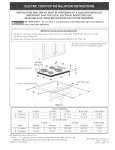
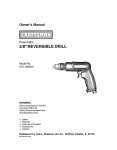
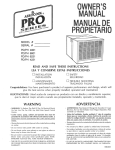
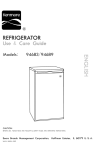
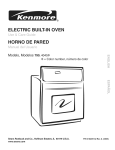

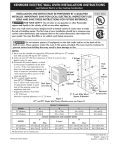
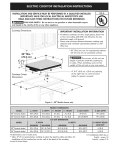
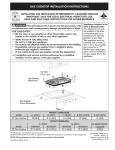
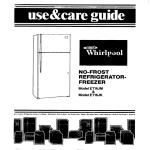
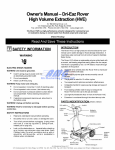




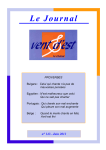
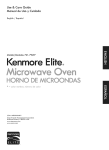
![MA`Y]`AG - Sears Parts Direct](http://vs1.manualzilla.com/store/data/007303854_1-7b2ede6b3b7c67d12ad1099d2b48982d-150x150.png)
